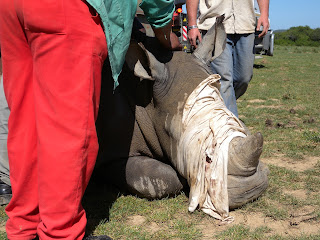We had to be up at 3.30am on Tuesday. I didn't sleep too well the night before as I knew I had to get up - a bit like when you have to catch an early flight, except this time it was to catch a rhino. As we later found out, we actually had four rhinos to catch. I feel like I am on a mission at the moment to help move all the animals in South Africa. Not that I am helping that much. Generally I just try and stay out of the way and let the experts get on with what they're doing.
We were moving white rhinos this time. Aside from the obvious lighter colour compared to black rhinos, they also have much longer and pointier horns. When we arrived at the breeder's, they were casually grazing the pasture area and seemed reasonably placid. There were three adults and a calf.
One of the adult females was darted first - from a truck this time. However, they soon began stampeding towards the thicket and we knew we had to try and divert them towards a track to make it easier to move. The helicopter was put into action again to steer them in the right direction. It was the same pilot that took me up last week for the buffalo darting.
Luckily, the rhino ended up falling right on a track, albeit reasonably deep into the thicket. I am becoming more familiar with the procedure now - blindfolds on, ear plugs in. After this, the vet measured the rhino's horn and then the next step completely took me by surprise. A chain saw - which I thought was there to cut any thicket that the rhino might have fallen into - was deployed to cut the rhino's horn off. I was completely take aback. Having heard all the stuff about the poachers, the last thing I expected was to see was someone chain-sawing the horn off, even if it was legitimately done.
I was told that owners will sometimes remove the horns to discourage poachers from killing the animal. However, it appears that poachers will still kill a de-horned rhino. They have invested effort tracking the animals and will ruthlessly kill even the ones without horns to remove them from the market and make sure they don't waste any time tracking the same animal again.
At the end of the process, I was not sure how I felt about it. I understand the good intentions, but the poor animal had lost its trademark and just didn't look the same. Even the vet acknowledged that it was "degrading but necessary". The horn will grow again at a slow rate, but I found the process quite distressing to watch.
Once the horn was removed, a microchip was inserted into the animal - something that is becoming standard procedure now so the appropriate authorities can track the animal too. There is also a lot of administration that is necessary before any endangered species can be moved. The owner has to have a licence to move it and the National Conservation organisation took a record of all the microchip numbers. They also had one of their staff there to observe the whole procedure to ensure it was done correctly. The vet also made cuts into the rhino's ears to give it a visibly recognisable mark for that individual animal. The way they are handled seems very much like cattle on a farm in some respects.
The second rhino was darted from the helicopter this time and the same process followed, including the removal of the horn. The last two to be darted were the mother and its calf. The two were darted simultaneously from the helicopter so as not to stress the calf when the mother went down. The vet had his work cut out trying to handle both animals at the same time. I am happy to say that the calf did not have its horn removed because it was too young and the horn was not that big anyway.
In addition to the rhinos, the removed horns were also micro-chipped. Even the shavings that were left over after the chain-sawing were bagged up and kept. I was told that the breeder who has bought them has around 30 rhinos and has had all their horns removed. He is apparently storing them in a safety deposit box and planning to keep them until the day that selling rhino horn becomes legalised. At that point, he hopes to make his fortune. Not your usual investment strategy. One of the locals told me that many people think that selling rhino horn should be legalised and should be farmed and removed in a humane way.
The four rhinos were walked into crates and then lifted onto the transportation truck. They were dowsed with water in the crates to keep them cool. They were destined for a rhino farm in the north west of the country and had an 8-10 hour journey ahead of them. It was quite a convoy.










No comments:
Post a Comment